
When you are the King of Prussia, Frederick the II (aka Frederick the Great), and you enjoy beauty, art, philosophy – AND you didn’t really want to become king (that is – until your father executes a childhood friend right in front of your eyes), what do you do? You rebel as best as you can by trying to make things better – for everyone. Let me Explain.
Frederick was a proponent of enlightened absolutism. Simply put, Fred embraced the principles of the Enlightenment, with its emphasis upon rationality and applied these principles to his territories through religious tolerance, freedom of speech and the press, and the right to hold private property. In addition, he worked to encourage the arts, sciences, and education. How did he do this? He became friends with great thinkers like Voltaire and worked to modernize Prussian bureaucracy and civil service, oh – and he composed music – for the flute. Yes, the flute. Now, in modern society, we would naturally, assume, he was gay. Maybe he was – after all, despite being Married to Princess Elisabeth-Christine – he died childless – but hard telling – because back then, it would have been something swept under the rug….but you can read more about his life (and sexuality speculation here) if you want.
Anyhow, during his reign, as a part of his beliefs (he was, after all, well educated and very liberal for his time) he thought that he should rest in beautiful palaces – his favorite, was Sansoussi, near Potsdam (flickr set here), where he died. His second favorite, however, he spent several years in – just before he came to power. It is Rheinsberg Palace (pictured above), located in the North of Brandenburg. It was here, in Rheinsberg, that Fred assembled a small number of musicians, actors and other artists. He spent his time reading, watching dramatic plays, making and listening to music, and regarded this time as one of the happiest of his life. Seeing the palace above, I can understand why.
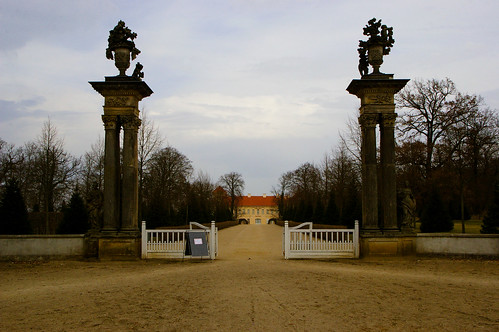
The grounds are, even today – magnificent. When you enter through the gates, erected between 1734-1744, you get an immediate sense of grandeur. At one end there’s the brilliant yellow palace, framed through the column gates. The columnades and hedges along the entryway instill a sense of balance, and the female Greek goddesses you pass by on either side a sense of the classical and the timeless.
Partway down the main entryway path, you come to a cross road. In front, there is the main palace and its white carriageway bridge. To the Right, there is a path that continues into a wooded area filled with trees and paths to wander. To the Left, is the entryway to the maze and path around the far side of the palace. I chose to go to the left, because the weather was nice, and a storm was moving in. At the heart of the maze’s wide pathway, there is a lovely gazebo which is surrounded by several white marble Roman style statues. It has a tiled “sun pattern” floor, and the ceiling inside is a mosiac patterned cherub (no pictures, unfortunately they didn’t come out).
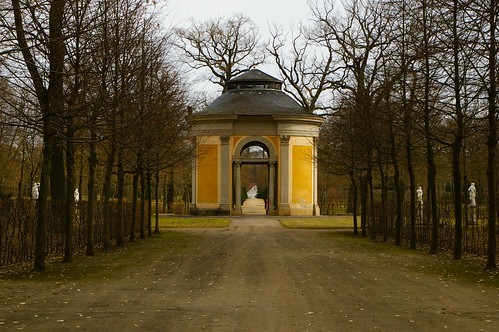
From there, I proceeded on, past a terraced hill of grape vines and down into the marsh area where you can choose to go across a wooden bridge (it looked not so sturdy from far away):
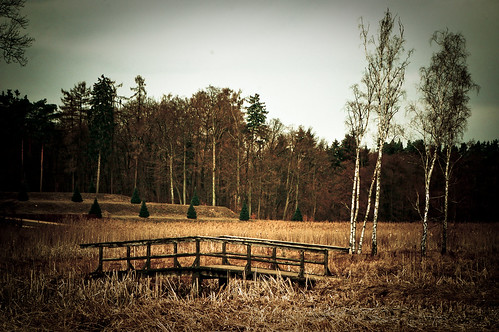
or head toward a man made grotto and pond – which was added during the expansion of the garden area between 1752 -1802 by Henry (Fred’s brother).
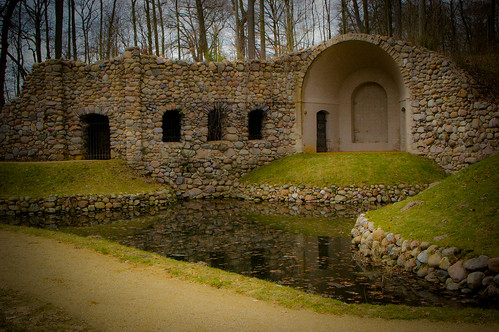
The Grotto is now closed and locked up (I walked around in front of it) but I can just imagine playing in there on a hot summer’s day – the inside is large enough for a couple of benches and a card sized table – with the fountain down the one side gently gurgling away.
As I continued along the path around the edge of the lake, more woods appeared and a large marshy area filled with cat-tails. A small sign says that this is where the old boathouse once was – just as the rear view of the palace starts to come into view. At the same time, up to the left, a grassy terraced hill begins – a hill that once belonged to the townfolk of Rheinsberg but was confiscated by Henry during the expansion of the grounds – and it is topped with a huge oblisk surrounded by a green fence.
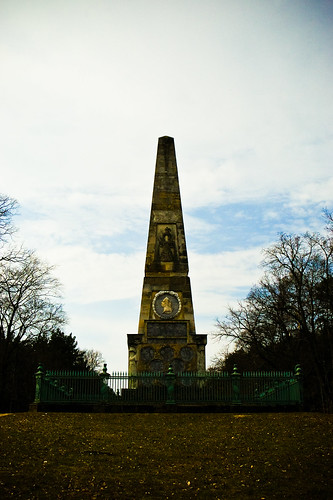
On the Oblisk are several profile medallions – and dedications to various kings / queens / princesses of Prussia. The pathway continues on; leading around the hill. Upon turning around, I realize I’ve reached my main objective – and wait on the light to give me what I want – a photograph of the Palace and it’s Guesthouse reflected in the lake in the sunshine… And so I wait. 5 minutes, 15 minutes, 20 minutes, baking in the humidity, I set up the camera, tripod and timer. I strip off my sweat jacket and wonder if the clouds will part and the water still…. People pass by. They climb the hill and wander around us. Finally, I give up – to head toward the palace itself – and decide to have Michael snap a photo of me, shrugging – the “what can ya do?” expression….
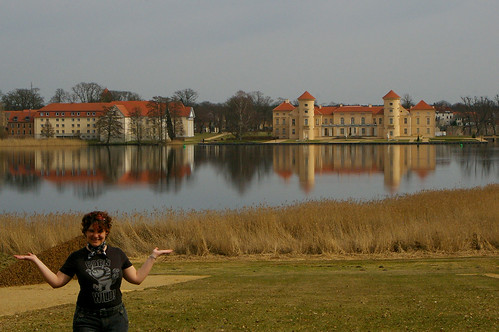
And then.. as I start to take the camera off the tripod, the clouds part over me – and the winds calm just enough to give me this:

which I was quite pleased with. Heading back around the lake, the sun grew more intense, and with just moments to spare, I managed to snap two more views of the palace – before the sun left for a few hours — and the intermittent rain showers began.
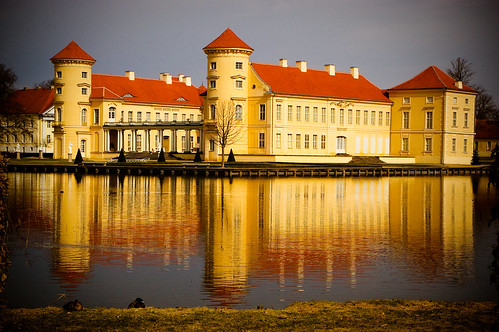
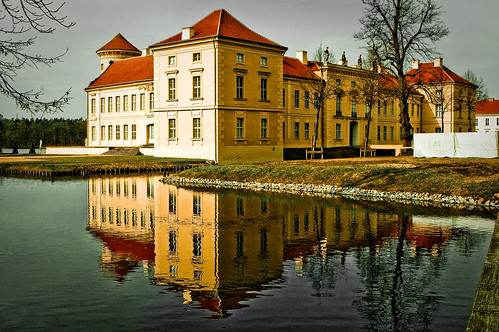
All in All, not a bad day for photographing a Palace – though I do think I want to go back when it’s in bloom, later this summer, with a picnic — to find a Place at a Palace to Relax.



well done! the 2nd to last is my favorite. that grotto is a DREAM – such a shame that it’s closed. 🙁
Yah – I have seen several on/around the palaces here, and I think someday I may have to figure out a way to build one on some property somewhere. The way they’re built into the side of the hill is very simple, but yet, so relaxing by use-able space standards. My thought is that in the US, where summers are so much warmer than here, how much cooler would it be inside one with all the stone – and yet – still able to have the breeze and light filter in…